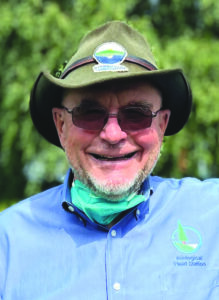Harmful Algae Bloom in Otsego Lake

Funding is always a challenge with Otsego Lake no matter what the problem or opportunity may be.
“The new problem is actually an old problem. It’s the algae bloom and the quagga mussels that we predicted back in 2018 that are still here, but they are causing greater problems,” said Paul Lord, environmental scientist at the Biological Field Station in Cooperstown.
“I told the board of directors of Otsego Lake Association that we were going to have a problem, and this was the summer for that problem. In October when we were doing our deepest check in the lake, we were finding 8 or 9 quagga mussels per square meter at about 160 feet down,” Mr. Lord said.
That in itself didn’t mean much but given the reproductive potential of the quagga mussels; it could be worse.
“I predict when we make that same check in October of this year, there will be 100s of quagga mussels per square meter. And that’s a problem.”
Every quagga and zebra mussel filters about one gallon of water a day. They eat plankton, zooplanktons, but they don’t like to eat cyanobacteria at all.
“This is like having a cow in a pasture and you want the cows to eat everything, but they don’t like the thistle. The pasture gets over run with the thistle. That’s what is happening with the lake right now, we are getting overrun with quagga mussels,” Mr. Lord said.
“The algae bloom comes to the surface on quiet mornings and wind pushes it to the shore line. The bloom is distributed throughout the water column and comes in on quiet days with no wind. Then it rises to the surface and grabs the sunlight. The wind pushes it, and that is what makes it hazardous. It can make you pretty sick.”
If waves are breaking on the beach, that means the wind is pushing algae that way so you should close the windows in your house and put the AC on.
“It costs a lot of money to monitor. It’s very expensive to test the waters, so people become complacent. If the water looks good, they still go in. The toxin is a neurotoxin,” Mr. Lord said.
“The symptoms of exposure are sore throat, red and runny eyes, maybe trouble breathing,” he said. There isn’t anything to do to eradicate this.
“My advice to people? Pay attention to when the wind is pushing the waves onto the beach areas. The algae blooms are going to come on stronger and earlier in future years. I’m not saying don’t use the lake, enjoy it, just be aware of the wind. Swim on the upwind side of the lake, go out on your boat, and stay safe.”
If you want more information, Mr. Lord suggests reading Death and Life of the Great Lakes. “It describes in great detail what we can expect over the next six years. The New York Department of Health website, www.health.ny.gov, has all of the authoritative information on the subject,” he said.
“We aren’t going to be able to afford regular testing of the lake without significant funding. The bottom line, in my opinion as a scientist, is that the algae blooms we are being subjected to are a hazardous risk. Don’t drink the water, test the water if you are using it in your house. But still enjoy our beautiful lake.”


What does it look like. Have seen white suds on east side between Kingfisher and Fairy Spring.
What does it look like. Have seen white suds on east side between Kingfisher and Fairy Spring.
I work with Paul and know that he requested two corrections in this article in an email to the writer in the morning of 12 Aug 2022: zooplankton, not “zoe planktons” and swim UPWIND of a known bloom, not downwind. Surface scum gets pushed to the downind direction. Please make the corrections ASAP. Thank you.
I work with Paul and know that he requested two corrections in this article in an email to the writer in the morning of 12 Aug 2022: zooplankton, not “zoe planktons” and swim UPWIND of a known bloom, not downwind. Surface scum gets pushed to the downind direction. Please make the corrections ASAP. Thank you.
Is there any fall 2022 quagga population data?
Is there any fall 2022 quagga population data?